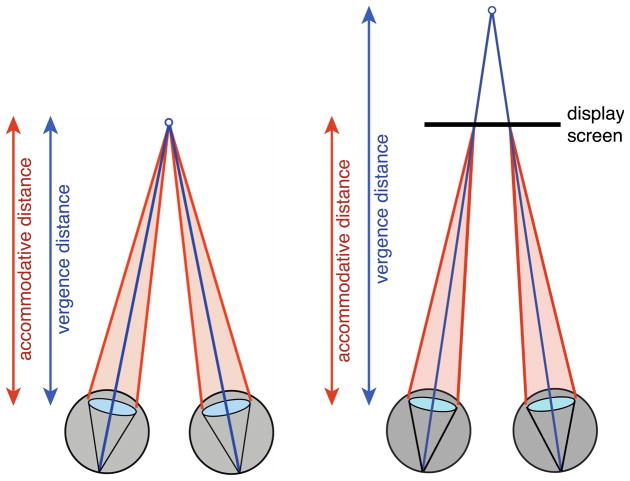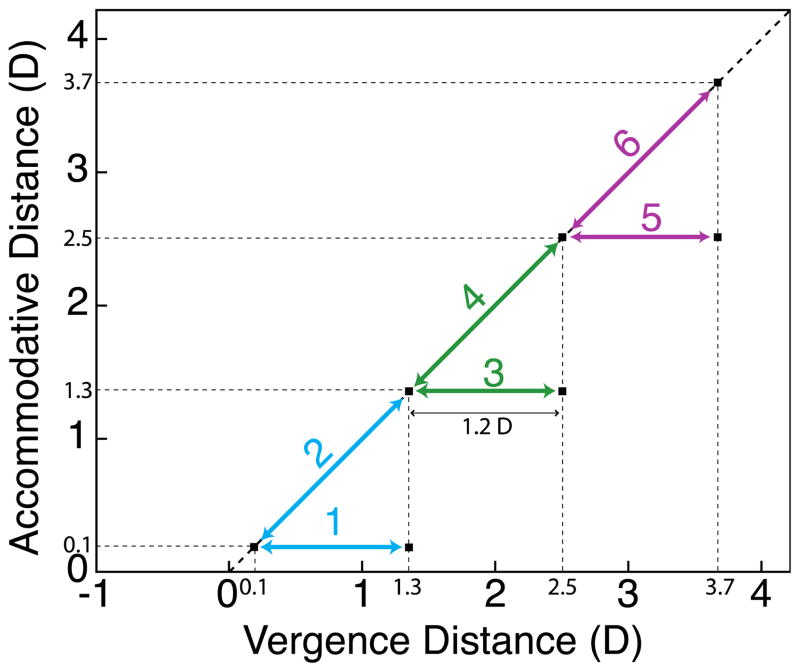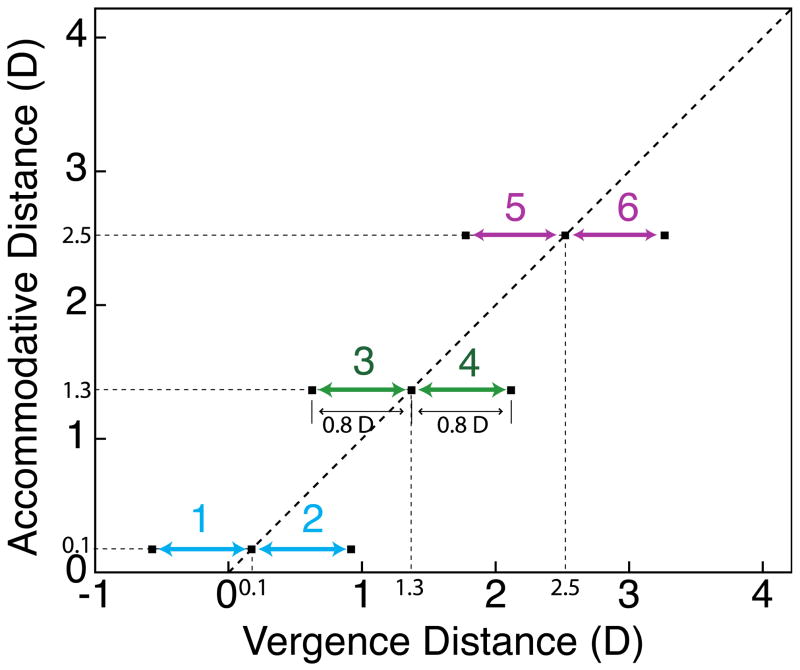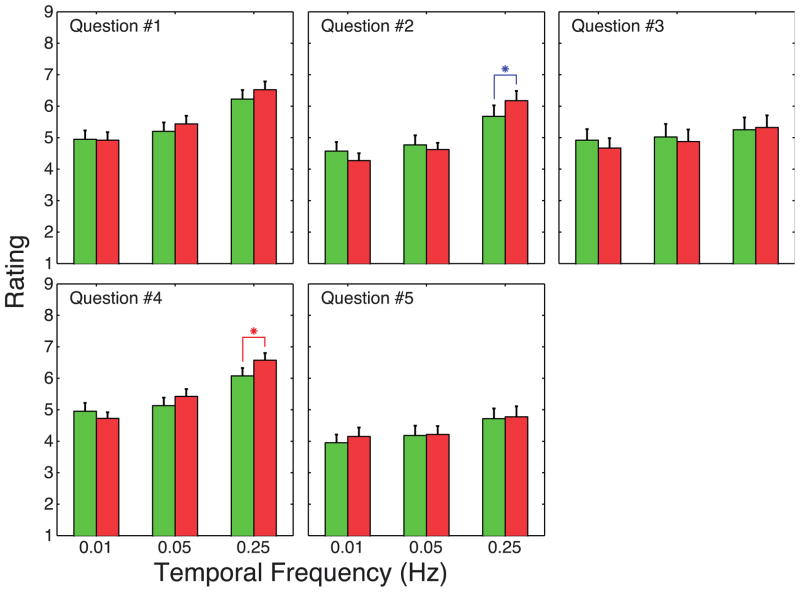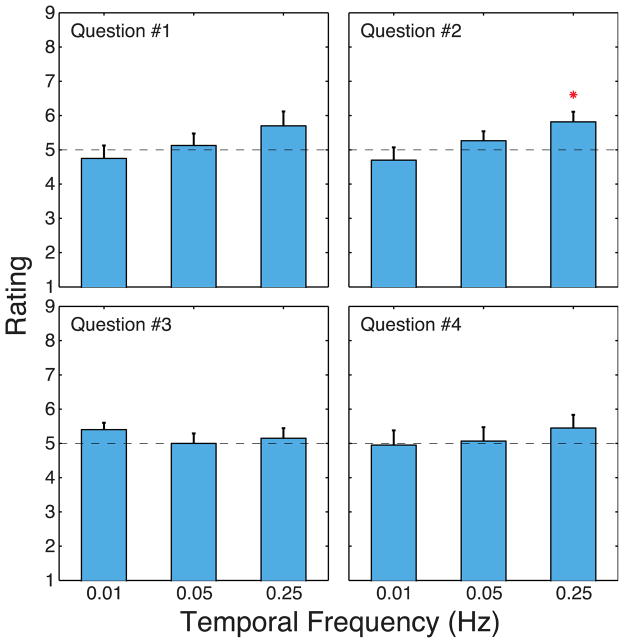Abstract
Prolonged use of conventional stereo displays causes viewer discomfort and fatigue because of the vergence-accommodation conflict. We used a novel volumetric display to examine how viewing distance, the sign of the vergence-accommodation conflict, and the temporal properties of the conflict affect discomfort and fatigue. In the first experiment, we presented a fixed conflict at short, medium, and long viewing distances. We compared subjects’ symptoms in that condition and one in which there was no conflict. We observed more discomfort and fatigue with a given vergence-accommodation conflict at the longer distances. The second experiment compared symptoms when the conflict had one sign compared to when it had the opposite sign at short, medium, and long distances. We observed greater symptoms with uncrossed disparities at long distances and with crossed disparities at short distances. The third experiment compared symptoms when the conflict changed rapidly as opposed to slowly. We observed more serious symptoms when the conflict changed rapidly. These findings help define comfortable viewing conditions for stereo displays.
Keywords: stereo display, vergence-accommodation conflict, visual fatigue, comfortable stereo viewing, viewing distance
1. INTRODUCTION
There is increasing interest in the technology for presenting stereo 3D (S3D) imagery in cinema, television, gaming, and mobile devices. The increasing interest has been accompanied by public concern about visual discomfort and fatigue associated with prolonged viewing of stereo imagery. Clearly, a significant hurdle for the emerging technology is to determine how serious the discomfort and fatigue are, and how to reduce or eliminate them.
There are numerous potential causes of visual discomfort when viewing stereo displays. These include discomfort due to the eyewear required to separate the two eyes’ images, ghosting or cross-talk between the two eyes’ images, misalignment of the images, inappropriate head orientation, vergence-accommodation conflict, visibility of flicker or motion artifacts, and visual-vestibular conflicts1. Here we focus on the vergence-accommodation conflict for two reasons. First, it is present in all conventional stereo displays, while the other factors are not present in some instantiations of stereo display technology. Second, the visual discomfort and fatigue associated with the viewing of stereo displays has often been attributed to vergence-accommodation conflicts2–9. Unfortunately, the great majority of those publications did not present persuasive evidence that the reported symptoms were caused specifically by the vergence-accommodation conflict, so one purpose of the current study is to investigate whether such conflicts do indeed cause visual discomfort.
Figure 1 shows the difference between natural viewing and stereo viewing. In natural viewing, vergence and accommodative distance are equal to one another as shown on the left. The viewer adjusts the vergence of the eyes to look at an object and thereby perceive a single fused image rather than two. The viewer’s eyes also focus in order to perceive a sharp rather than blurred image. Because of the tight correlation in natural viewing, vergence and accommodation are neurally coupled. Specifically, accommodative changes evoke changes in vergence (accommodative vergence), and vergence changes evoke changes in accommodation (vergence accommodation)10. In stereo viewing on conventional stereo displays, accommodative distance is fixed at the distance from the eyes to the display screen, while vergence distance varies depending on the distance being simulated on the display. This creates the so-called vergence-accommodation conflict associated with stereo displays: To see the object singly and clearly, the viewer must counteract the neural coupling between vergence and accommodation to accommodate to a different distance than the distance to which he/she must converge. Visual fatigue and discomfort may occur as the viewer attempts to adjust vergence and accommodation appropriately.
Figure 1.
Diagram of natural and stereo viewing. The left side of the figure represents natural viewing. In natural viewing, the vergence stimulus and accommodative stimulus are always at the same distance and therefore are consistent with one another. The right side of figure represents stereo viewing on a conventional stereo display. Stereo viewing creates inconsistencies between vergence and accommodative distances because the vergence distance varies depending on the image contents while the accommodative distance remains constant.
S3D’s growing popularity has let to adoption for applications beyond cinema. It is now found in television, mobile phones and cameras, and video game systems. A result of this trend is that people will be viewing stereo images at several different viewing distances. Findings from the optometric literature suggest that the discomfort associated with a given vergence-accommodation conflict may increase with increasing viewing distance, and that discomfort might be greater with uncrossed than with crossed disparity. In this study, we used a volumetric stereo display that presents correct or nearly correct focus cues11 to present stereo images with or without vergence-accommodation conflict. In the first experiment, we measured the discomfort/fatigue associated with vergence-accommodation conflict at different distances. In the second experiment, we investigated the interaction of the sign of the conflict and viewing distance on discomfort and fatigue. In the third experiment, we investigated how the temporal properties of the conflict affect discomfort and fatigue.
2. EXPERIMENT 1: EFFECTS OF VERGENCE-ACCOMMODATION CONFLICT AT DIFFERENT DISTANCES
We first investigated the effect of viewing distance on the visual discomfort that accompanies a vergence-accommodation conflict of a given magnitude in diopters. A complete account of this experiment and the data is provided by Shibata and colleagues.11
2.1. Methods
Twenty-four subjects, 19 to 33 years of age, participated. All had normal stereoacuity. Those who normally wear optical correction wore their correction while doing the experiment. We checked that they could accommodate to all the accommodative distances and converge to all the vergence distances in the experiment. All subjects were unaware of the experimental hypotheses.
We used a stereoscopic volumetric display that can manipulate vergence and accommodative stimuli independently12. The apparatus presented four image planes at distances of 0.1D, 0.7D, 1.3D, and 1.9D. To simulate other accommodative distances, we used depth-weighted blending13,14.
The six experimental conditions are depicted in Figure 2. Two distances were presented in each sub-session: a base distance and an increment distance. Three of the conditions were cues-consistent such that the vergence and accommodative distances were always equal to one another; these conditions simulate natural viewing. Three of the conditions simulated cues-inconsistent viewing in which the accommodative distance was constant while the vergence distance changed; these conditions simulate the viewing of stereo displays. The experiment was divided into three sessions conducted on three consecutive days. Each session consisted of two sub-sessions conducted on the same day. A pair of sub-sessions always consisted of a cues-consistent sub-session and a cues-inconsistent sub-session at one base distance. In a cues-consistent sub-session, the base vergence and accommodative distances were either 10m (0.1D), 77cm (1.3D), or 40cm (2.5D) and the increment vergence and accommodative distances were respectively at distances of 77cm (1.3D), 40cm (2.5D), or 27cm (3.7D). In a cues-inconsistent sub-session, the base vergence and accommodative distances were the same as in the cues-consistent sub-session, but the increments were 1.2D for the vergence stimulus and 0D for the accommodative stimulus. Thus, subjects had to uncouple vergence and accommodation to maximize performance in this condition. Note that the vergence stimuli were the same in the paired sub-sessions: The only difference was the accommodative stimulus, which was equal to the vergence stimulus in the consistent condition and fixed in the inconsistent condition. The ordering of the cues-consistent and cues-inconsistent conditions was random. Neither the subject nor experimenter knew whether a given sub-session was cues-consistent or -inconsistent.
Figure 2.
The vergence and accommodative stimuli in Experiment 1. Vergence distance in diopters is plotted on the abscissa and accommodative distance in diopters on the ordinate. The diagonal arrows represent the stimuli in the three cues-consistent conditions (2, 4, & 6). In those conditions, the vergence and accommodative distances were always equal to one another; within the 3-interval trials, they changed by 1.2D as indicated by the arrows. The horizontal arrows represent the stimuli in the three cues-inconsistent conditions (1, 3, & 5). In those conditions, the vergence distance changed in the same way as in the cues-consistent conditions, but the accommodative distance remained fixed.
Three stimuli were presented sequentially on each trial. The sequence on each trial was base-increment-base or increment-base-increment. Two of the presentations contained one corrugation orientation (+10 or −10° from horizontal) and the other contained the opposite orientation (−10 or +10°). Each presentation interval lasted 1.5s with 1s in between, so the 3-interval sequence lasted 5.5s. The subject’s task was to identify the interval containing the odd orientation; this is a 3-interval, forced-choice oddity task. Auditory feedback was provided at the end of each trial. A sub-session contained 219 trials and lasted ~20 min. We varied the spatial frequency of the stimulus corrugations (1, 1.4, and 2cpd) according to the method of constant stimuli. We recorded percent correct performance in the oddity task for each corrugation frequency and each experimental condition.
At the end of each sub-session, subjects completed a symptom questionnaire based on the one used by Hoffman and colleagues4. Observers rated their symptoms on a 5-point scale where 1 indicated no negative symptoms at all and 5 indicated severe symptoms. The questions were:
How tired are your eyes?
How clear is your vision?
How tired and sore are your neck and back?
How do your eyes feel?
How does your head feel?
Question 3 was a control question to make sure that subjects were responding specifically to the individual question. We expected no difference in reported symptoms for this question. After answering the questions, subjects took a mandatory break that lasted at least 30 min. After the break, subjects participated in the second sub-session of the pair. At the end of a pair of sub-sessions, they completed an additional comparison questionnaire. It had four questions:
Which session was most fatiguing?
Which session irritated your eyes the most?
Which session gave you more headache?
Which session did you prefer?
2.2. Results
All subjects reported discomfort and/or fatigue after each session. Figure 3 shows the average reported symptoms on the symptom questionnaire. Striped bars represent the reported symptoms after the three cues-inconsistent sessions (conditions 1, 3, and 5), and solid bars represent the reported symptoms after the three cues-consistent session (conditions 2, 4, and 6). The black, gray and off-white bars represent long, middle, and near base viewing distances. The ordinate represent the severity of symptoms from the 5-point scale: ‘5’ indicates the most severe symptom, and ‘1’ indicates the observer did not experience symptoms.
Figure 3.
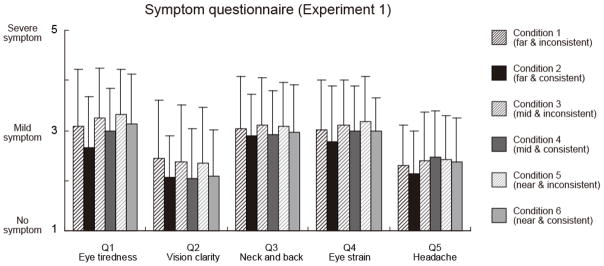
Results from the symptom questionnaire in Experiment 1. The average severity of reported symptoms is plotted for each of the five questionnaire items. The darker bars represent longer base viewing distances. Striped bars represent the reported symptoms after the three cues-inconsistent sessions (conditions 1, 3, and 5), and solid bars represent the reported symptoms after the three cues-consistent session (2, 4, and 6). The ordinate represents the severity of symptoms. Larger values are associated with more severe symptoms. Error bars represent one standard deviation.
For question 1, eye tiredness was significantly more severe in the cues-inconsistent sub-session than the cues-consistent sub-session at 0.1D (10m) (Wilcoxon signed-rank test, p<0.025, one-tailed). For question 2, observers reported significantly more blurriness during the cues-inconsistent session at 1.3D (77cm) (Wilcoxon signed-rank test, p<0.005, one-tailed), and marginally more in the cues-inconsistent session at 0.1D (10m) and 2.5D (40cm) distance sessions (Wilcoxon signed-rank test, p<0.05, one-tailed). For questions 3, 4 and 5, there were no significant differences.
Figure 4 shows the results for the session-comparison questionnaire. Higher values indicate more favorable ratings for the cues-consistent session. ‘3’ indicates the two sub-sessions were equally favored. The preference for the cues-consistent condition at the 0.1D (10m) distance was statistically significant for questions 1 and 2 (Wilcoxon signed-rank test, p<0.005, one-tailed), which dealt with general fatigue and eye irritation. For general display preference, there was a marginally significant difference for the 2.5D (40cm) distance (question 4, Wilcoxon signed-rank test, p<0.05, one-tailed).
Figure 4.
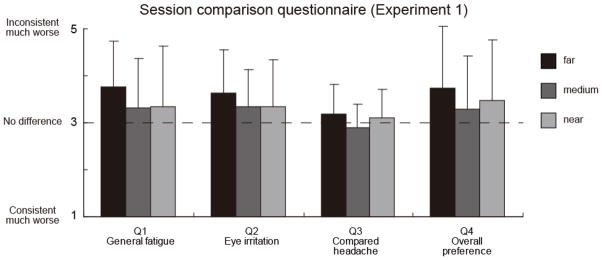
Results from the session comparison questionnaire in Experiment 1. The average comparative rating of a pair of sub-sessions (one cues-consistent and one cues-inconsistent) is plotted for each of the four questionnaire items. The ordinate represents which sub-session was more favored. Higher values indicate more favorable ratings for the cues-consistent session. ‘3’ indicates the two sub-sessions were equally favored. Error bars represent one standard deviation.
3. EXPERIMENT 2: EFFECTS OF DIRECTION OF VERGENCE-ACCOMMODATION CONFLICT AT DIFFERENT DISTANCES
We next investigated how the sign of the vergence-accommodation conflict affects visual discomfort at different viewing distances. A complete account of this experiment and the data is provided by Shibata and colleagues.11
3.1 Methods
Fifteen subjects, 20–34 years of age, participated. Many of them had also participated in Experiment 1. Again all had normal stereovision, wore their normal optical correction, and were unaware of the experimental hypotheses.
The same equipment, stimuli, procedure, and response measures were used in Experiment 2 with a few exceptions, which are noted here. There were again two sub-sessions in each session, but both sub-sessions contained a fixed accommodative distance and were therefore cues-inconsistent. In one sub-session, the vergence-accommodation conflict was positive (vergence distance greater than accommodative distance in diopters, crossed disparity) while in the other, it was negative (vergence distance less than accommodative distance in diopters, uncrossed disparity). These conditions are depicted in Figure 5. The change in vergence distance was always ±0.8D, while the accommodative distance remained constant within a sub-session. Pairs of sub-sessions were presented on consecutive days at accommodative distances of 0.1D (0.1m), 1.3D (77cm), and 2.5D (40cm). The ordering of sub-sessions and sessions was randomized. Neither the experimenter nor the subject knew if the current sub-session contained positive or negative vergence-accommodation conflict.
Figure 5.
The vergence and accommodative stimuli in Experiment 2. Vergence distance in diopters is plotted on the abscissa and accommodative distance in diopters on the ordinate. The horizontal arrows represent the stimuli in the six conditions. Three of those conditions (2, 4, & 6) involved positive vergence-accommodation conflicts in which the vergence distance in diopters was greater than the accommodative distance in diopters. The other three conditions (1, 3, & 5) involved negative conflicts (vergence distance in diopters less than accommodative distance in diopters). In all conditions, vergence distance changed, but accommodative distance remained constant.
3.2 Results
Even with the reduced 0.8D vergence change, all subjects reported fatigue and/or discomfort after each session. Figure 6 shows the average reported symptoms on the symptom questionnaire. Upper-left striped bars represent the reported symptoms after the three negative conflict sessions (uncrossed disparity; conditions 1, 3, and 5), and upper-right striped bars represent the reported symptoms after the three positive conflict sessions (crossed disparity; conditions 2, 4, and 6). Darker bars represent longer base viewing distances. We focused on the difference between positive and negative conflicts at each viewing distance in order to examine the distance effect.
Figure 6.

Results from the symptom questionnaire in Experiment 2. The average severity of reported symptoms is plotted for each of the five questionnaire items. Upper-left striped bars represent symptoms after the three negative conflict (uncrossed disparity) sessions (conditions 1, 3, and 5), and upper-right striped bars represent the reported symptoms after the three positive conflict (crossed disparity) sessions (2, 4, and 6). The darker bars represent longer base viewing distances. The ordinate represents the severity of symptoms. Larger values are associated with more sever symptoms. Error bars represent one standard deviation.
For eye tiredness (question 1), negative conflict (uncrossed disparity) was significantly worse for the session at 0.1D (10m) (Wilcoxon signed-rank test, p<0.05, two-tailed). With the smaller vergence change, blurriness (question 2) was generally not reported. Question 4 revealed that the eyes felt significantly worse with negative (uncrossed) conflict when the viewing distance was far, 0.1D (10m) (Wilcoxon signed-rank test, p<0.05, two-tailed), and that the eyes felt significantly better with negative conflict when the viewing distance was near in the 2.5D (40cm) distance session (Wilcoxon signed-rank test, p<0.01, two-tailed). There was generally a minimal amount of head discomfort reported and the only condition with a significant difference was for the 1.3D (77cm) distance (question 5, Wilcoxon signed-rank test, p<0.05, two-tailed), in which the crossed disparities were worse. In our control question, related to neck and back pain, there were no significant differences.
Figure 7 shows the results for the session-comparison questionnaire. Higher values indicate more favorable ratings for the positive conflict session (crossed disparity). As mentioned before, ‘3’ indicates the two sub-sessions were equally favorable. At the far distance (10m, 0.1D) there was a statistically significant preference for the crossed-disparity viewing situation in terms of general fatigue (question 1, Wilcoxon signed-rank test, p<0.05, two-tailed), and marginally significant preference for the crossed-disparity viewing situation in terms of eye irritation (question 2, Wilcoxon signed-rank test, p<0.10, two-tailed), headache (question 3, Wilcoxon signed-rank test, p<0.10, two-tailed), and overall preference (question 4, Wilcoxon signed-rank test, p<0.10, two-tailed). At the mid distance, uncrossed disparity caused marginally worse fatigue (question 1) and eye irritation (question 2) (Wilcoxon signed-rank test, p<0.10, two-tailed).
Figure 7.
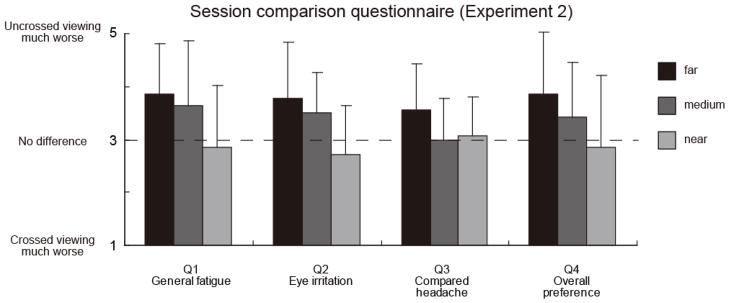
Results from the session-comparison questionnaire in Experiment 2. The average comparative rating of a pair of sub-sessions (one positive conflict and one negative conflict) is plotted for each of the four questionnaire items. The ordinate represents which sub-session is more favored. Higher values indicate more favorable ratings for the positive (crossed disparity) conflict session. ‘3’ indicates the two sub-sessions were equally favored. Error bars represent one standard deviation.
4. EXPERIMENT 3: TEMPORAL PROPERTIES OF VERGENCE-ACCOMMODATION CONFLICT
Vergence and accommodative responses have three components: tonic, phasic, and cross-link. The tonic components change slowly and are responsible for long-term adaptation. The phasic components change quickly enabling fast reaction. Thus, these two mechanisms are complementary: one dealing with rapid stimulus changes and the other helping to maintain the response. The cross-links are driven by the phasic components, so accommodative vergence (changes in vergence due to accommodation) and vergence accommodation (changes in accommodation due to vergence) are determined by relatively rapid changes in input13,14. For this reason, we hypothesize that fast changes in the conflict between vergence and accommodation—where the cross-links will be driven by the phasic components of vergence and accommodation—will be more uncomfortable than slow changes—where the cross-links will not be driven at all. We hypothesized therefore that faster changes in vergence-accommodation conflict associated with fast motion in depth will cause more visual discomfort in S3D viewing. To test this, we performed an experiment that measured the visual discomfort caused by different rates of variation in the vergence-accommodation conflict.
4.1 Methods
Twenty-four subjects, 22 to 31 years of age, participated. All had corrected-to-normal visual acuity and stereoacuity. All were unaware of the experimental hypothesis.
The stimuli were random-dot stereograms that simulated sinusoidal corrugations in depth. Dot density was 43 dots/deg2, corrugation frequencies were 1, 1.55, and 2.4cpd, and peak-to-trough amplitude was 2.2 minarc. These stimuli required reasonably accurate vergence and accommodation to perceive the depth corrugation. We updated the stereogram every 1.4sec; subjects had to make accurate vergence and accommodative responses at least that often.
We presented three temporal frequencies of changes in the vergence and accommodative stimuli: 0.01Hz (slow), 0.05Hz (medium), and 0.25Hz (fast). At each frequency, we simulated natural and conflict (S3D) conditions. In the natural condition, the vergence and the accommodative distances changed together with a sinusoidal modulation from 0.1D (10m) to 1.3D (0.77m); thus, the vergence-accommodation conflict was zero throughout. In the conflict condition, the accommodative distance was fixed at 0.1D, which produced a 1.2D sinusoidal variation in the magnitude of the vergence-accommodation conflict.
We tested one temporal frequency on each of the three testing days. On a given day, subjects completed the natural and conflict-viewing sessions at the chosen frequency. Each session took 20 minutes. Between sessions the subject had a break of 15–30 minutes. The order of the sessions was random and neither the subjects nor the experimenter were aware of which condition was being presented.
Two questionnaires were used: a symptom questionnaire completed after each session and a comparison questionnaire completed after a pair of sessions. The symptom questionnaire had five questions concerning the degree of eye tiredness, clearness of vision, neck and backache, eyestrain, and headache. The comparison questionnaire had four questions concerning visual fatigue, eye irritation, headache, and general preference. Subjects responded on a 9-point scale.
4.2 Results
Figure 8 shows the average results from the symptom questionnaire. The severity of symptoms is plotted as a function of temporal frequency for each of the five questions. Green and red bars represent the results for the natural and conflict conditions, respectively. Subjects reported greater discomfort at higher temporal frequencies in both the natural and conflict conditions. We performed Wilcoxon signed-rank tests between natural and conflict-viewing session scores. Statistically significant differences are indicated by asterisks: significant (p<0.05, two-tailed) differences by red, and marginally significant (p<0.1, two-tailed) differences by blue. Only two pairs were significantly or marginally different where subjects felt more severe symptoms in conflict-viewing session; both were from the fast condition (0.25Hz) and the symptoms were blurriness of vision and eyestrain. Although not statistically significant, subjects reported more severe symptoms for general visual discomfort (Question 1) in conflict viewing in the fast condition.
Figure 8.
Results from the symptom questionnaire averaged across subjects. Each panel plots symptom rating (higher numbers representing more severe symptoms) as a function of temporal frequency. Different panels represent results for different questions. Green and red bars represent the results for the natural and conflict conditions, respectively. Red asterisks indicate statistically significant differences between natural and conflict viewing (p<0.05, two-tailed Wilcoxon signed rank test). Blue asterisks indicate marginal significant differences (p<0.10, two-tailed). Question 1 concerned eye fatigue, question 2 concerned clarity of vision, question 3 concerned the neck and back, question 4 concerned how the eyes felt, and question 5 concerned how the head felt.
Figure 9 shows the average results for the session-comparison questionnaire. The relative ratings for the two sessions are plotted as a function of temporal frequency. Different panels show the results for different questions. We observed a statistically significant increase in eye irritation at high frequency and marginally significant increases in fatigue and preference at high frequency. The results provide some confirmation for the hypothesis that faster changes in the vergence-accommodation conflict are more uncomfortable than slow changes.
Figure 9.
Results from the session-comparison questionnaire averaged across subjects. Ratings are plotted for each question and experimental condition. Ratings greater than 5 indicate that the natural condition was preferred to the conflict condition. Red, green, and blue represent respectively temporal frequencies of 0.01, 0.05, and 0.25Hz. Lighter colors represent the natural-viewing condition and darker colors the conflict condition. Question 1 concerned eye fatigue, question 2 concerned eye irritation, question 3 concerned how the head felt, and question 4 asked which session the subject preferred. Red asterisks indicate statistically significant differences between natural and conflict viewing (p<0.05, two-tailed Wilcoxon signed rank test).
5. DISCUSSION AND CONCLUSIONS
Using a novel volumetric stereoscopic display, we examined how viewing distance and the sign and temporal properties of the vergence-accommodation conflict affect discomfort and fatigue. The results from Experiment 1 show that subjects experienced significantly worse symptoms in cues-inconsistent sessions than in cues-consistent sessions, and that they preferred cues-consistent sessions. Most importantly, the difference in symptoms between cues-consistent and -inconsistent increased with greater viewing distance. The results from Experiment 2 showed that subjects generally experienced greater discomfort with uncrossed than with crossed disparity at the long viewing distance and the reverse at the short viewing distance. The results from Experiment 3 showed that there is a tendency for faster changes in the conflict to cause greater discomfort and fatigue.
The results from Experiment 1 reveal that the range of comfortable disparities changes with viewing distance. The range (expressed in diopters) becomes smaller with increasing distance. The results from Experiment 2 reveal that the sign of the vergence-accommodation conflict matters; crossed disparities are better tolerated at long distances and uncrossed disparities are better tolerated at short distances. Figure 10 summarizes the results by showing the range of vergence and accommodation distances that maintain viewer comfort. These plots are based on a model fit to the data from Experiments 1 and 2. The left panel plots those fits in diopters and the right panel plots them in units of distance. The horizontal lines in each panel show the viewing distances that are typical for different viewing devices.
Figure 10.
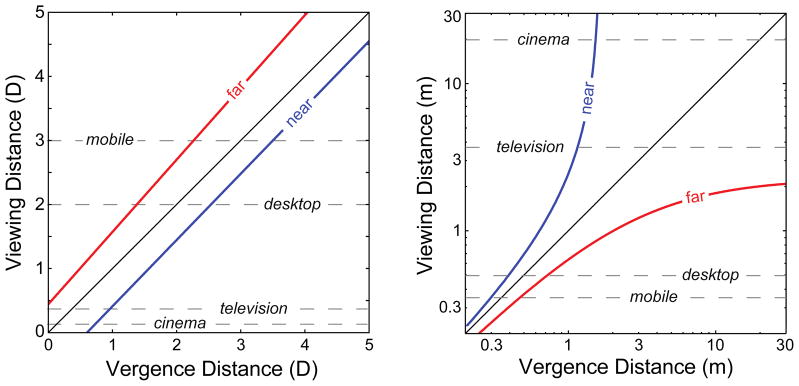
The zone of comfort in different units. Left panel: Comfort zone plotted in diopters. The abscissa is the distance of the vergence stimulus and the ordinate is the viewing distance, which corresponds to the accommodative stimulus. The black diagonal line represents natural viewing (demand line). The red and blue lines represent estimates from our data of the far and near boundaries of the comfort zone, respectively. The dashed horizontal lines represent typical viewing distances for mobile devices, desktop displays, television, and cinema. Right panel: Comfort zone plotted in meters. The abscissa and ordinate are the distance of the vergence stimulus and the viewing distance (i.e., the accommodative stimulus), respectively. The abscissa and ordinate are plotted on log scales. The black diagonal line again represents the natural-viewing line. The red and blue lines again represent the boundaries of the comfort zone. The dashed horizontal lines represent typical viewing distances for the same devices as in the previous panel.
The findings from our work should be valuable in tuning S3D content to be most comfortable for a given display configuration. The work also suggests that estimating the comfort of a film should be a process that is repeated under multiple circumstances to ensure that it is comfortable for the full audience, and for a variety of different common display viewing geometries.
References
- 1.Kooi FL, Toet A. Visual comfort of binocular and 3D displays. Displays. 2004;25:99–108. [Google Scholar]
- 2.Emoto M, Niida T, Okano F. Repeated vergence adaptation causes the decline of visual functions in watching stereoscopic television. Journal of Display Technology. 2005;1:328–340. [Google Scholar]
- 3.Häkkinen J, Takatalo J, Pölönen M, Nyman G. Simulator sickness in virtual display gaming: A comparison of stereoscopic and non-stereoscopic situations. Proceedings of the 8th conference on Human-computer interaction with mobile devices and services, ACM. 2006;159:227–229. [Google Scholar]
- 4.Hoffman DM, Girshick AR, Akeley K, Banks MS. Vergence-accommodation conflicts hinder visual performance and cause visual fatigue. Journal of Vision. 2008;8(3):33, 1–30. doi: 10.1167/8.3.33. [DOI] [PMC free article] [PubMed] [Google Scholar]
- 5.Lambooij M, Fortuin M, IJsselsteijn WA, Heynderickx I. Measuring Visual Discomfort associated with 3D Displays. Proceedings of SPIE; 2009. [Google Scholar]
- 6.Wann JP, Mon-Williams M. Measurement of visual after effects following virtual environment exposure. In: Stanney KM, editor. Handbook of virtual environments: Design, implementation, and applications. Lawrence Erlbaum Associates; New Jersey: 2002. pp. 731–749. [Google Scholar]
- 7.Ukai K, Howarth PA. Visual fatigue caused by viewing stereoscopic motion images: Background, theories, and observations. Displays. 2008;29(2):106–116. [Google Scholar]
- 8.Yano S, Ide S, Mitsuhashi T, Thwaites H. A study of visual fatigue and visual comfort for 3D HDTV/HDTV images. Displays. 2002;23:191–201. [Google Scholar]
- 9.Yano S, Emoto M, Mitsuhashi T. Two factors in visual fatigue caused by stereoscopic HDTV images. Displays. 2004;25:141–150. [Google Scholar]
- 10.Fincham EF, Walton J. The reciprocal actions of accommodation and convergence. The Journal of Physiology. 1957;137:488–508. doi: 10.1113/jphysiol.1957.sp005829. [DOI] [PMC free article] [PubMed] [Google Scholar]
- 11.Shibata T, Kim J, Hoffman DM, Banks MS. The zone of comfort: Predicting visual discomfort with stereo displays. Journal of Vision. 2011;11(8):11, 1–29. doi: 10.1167/11.8.11. [DOI] [PMC free article] [PubMed] [Google Scholar]
- 12.Love GD, Hoffman DM, Hands PJW, Gao J, Kirby AK, Banks MS. High-speed switchable lens enables the development of a volumetric stereoscopic display. Optics Express. 2009;17:15716–15725. doi: 10.1364/OE.17.015716. [DOI] [PMC free article] [PubMed] [Google Scholar]
- 13.Akeley K, Watt SJ, Girshick AR, Banks MS. A stereo display prototype with multiple focal distances. ACM Transactions on Graphics. 2004;23:804–813. [Google Scholar]
- 14.Ravikumar S, Akeley K, Banks MS. Creating effective focus cues in multi-plane 3D displays. Optics Express. 2011;19:20940–20952. doi: 10.1364/OE.19.020940. [DOI] [PMC free article] [PubMed] [Google Scholar]
- 15.Schor CM, Kotulak JC, Tsuetaki T. Adaptation of tonic accommodation reduces accommodative lag and is masked in darkness. Investigative Ophthalmolology and Visual Science. 1986;27:820–827. [PubMed] [Google Scholar]
- 16.Schor CM, Kotulak JC. Dynamic interactions between accommodation and convergence are velocity sensitive. Vision Research. 1985;26:927–942. doi: 10.1016/0042-6989(86)90151-3. [DOI] [PubMed] [Google Scholar]



